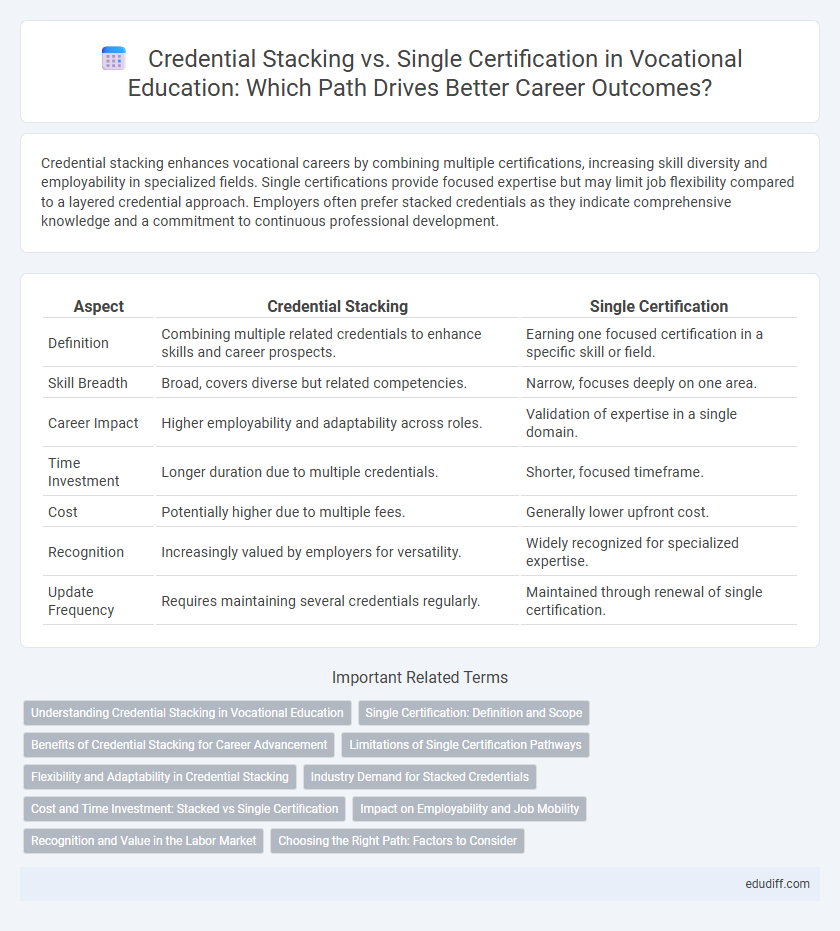Credential stacking enhances vocational careers by combining multiple certifications, increasing skill diversity and employability in specialized fields. Single certifications provide focused expertise but may limit job flexibility compared to a layered credential approach. Employers often prefer stacked credentials as they indicate comprehensive knowledge and a commitment to continuous professional development.
Table of Comparison
| Aspect | Credential Stacking | Single Certification |
|---|---|---|
| Definition | Combining multiple related credentials to enhance skills and career prospects. | Earning one focused certification in a specific skill or field. |
| Skill Breadth | Broad, covers diverse but related competencies. | Narrow, focuses deeply on one area. |
| Career Impact | Higher employability and adaptability across roles. | Validation of expertise in a single domain. |
| Time Investment | Longer duration due to multiple credentials. | Shorter, focused timeframe. |
| Cost | Potentially higher due to multiple fees. | Generally lower upfront cost. |
| Recognition | Increasingly valued by employers for versatility. | Widely recognized for specialized expertise. |
| Update Frequency | Requires maintaining several credentials regularly. | Maintained through renewal of single certification. |
Understanding Credential Stacking in Vocational Education
Credential stacking in vocational education involves accumulating multiple certifications that collectively enhance a worker's skills and employability, unlike a single certification which may cover only one specialty. This approach allows professionals to build a versatile skill set tailored to industry demands, increasing adaptability and career advancement opportunities. Employers increasingly value credential stacking as it demonstrates a broader competency range and commitment to ongoing professional development.
Single Certification: Definition and Scope
Single certification refers to obtaining a specific, standalone credential that validates expertise in a particular vocational skill or profession. It typically covers a defined scope of knowledge and competencies relevant to one discipline, offering focused career advancement opportunities. Employers recognize single certifications for their clarity in assessing specialized qualifications and job readiness within targeted industries.
Benefits of Credential Stacking for Career Advancement
Credential stacking enhances skill diversity, making professionals more adaptable to changing job markets and increasing employability across multiple industries. It signals a commitment to continuous learning and expertise, boosting credibility with employers and opening doors to advanced career opportunities. Compared to single certifications, stacked credentials provide a competitive edge by demonstrating a broader, well-rounded skill set tailored to evolving vocational demands.
Limitations of Single Certification Pathways
Single certification pathways often restrict career mobility by offering limited skill validation, which can hinder adaptability in evolving job markets. Employers increasingly favor candidates with diverse, stacked credentials that demonstrate comprehensive competencies across multiple disciplines. Relying solely on one certification may result in narrower professional opportunities and slower career advancement.
Flexibility and Adaptability in Credential Stacking
Credential stacking offers greater flexibility and adaptability compared to a single certification by allowing professionals to accumulate diverse, complementary skills tailored to evolving industry demands. This approach enables learners to customize their expertise through multiple micro-credentials, enhancing their ability to pivot across roles and sectors. Employers increasingly value stacked credentials for their demonstration of continuous learning and breadth of competencies in dynamic vocational landscapes.
Industry Demand for Stacked Credentials
Stacked credentials meet industry demand by combining multiple certifications that validate diverse skill sets, enhancing workforce adaptability and employability in dynamic job markets. Employers increasingly prioritize candidates with stacked credentials as they demonstrate comprehensive expertise and readiness for multifaceted roles. This approach aligns with labor market trends emphasizing continuous learning and versatile qualifications over single certifications.
Cost and Time Investment: Stacked vs Single Certification
Stacked certifications often require a higher initial time investment but offer long-term cost savings by combining multiple credentials into a cohesive skill set, enhancing employability and career advancement. Single certifications typically involve lower upfront costs and shorter study periods but may necessitate additional certifications later, increasing overall expenses and time commitments. Choosing credential stacking maximizes return on investment by streamlining professional development and reducing redundancy in learning.
Impact on Employability and Job Mobility
Credential stacking enhances employability by demonstrating a broader skill set and adaptability, making candidates more attractive to employers across various industries. In contrast, a single certification may limit job mobility as it typically validates expertise in a narrow field, reducing opportunities for lateral or upward career movement. Employers increasingly favor professionals with stacked credentials for their versatility and readiness to tackle diverse job roles.
Recognition and Value in the Labor Market
Credential stacking enhances recognition and value in the labor market by demonstrating a broader skill set and adaptability compared to a single certification. Employers increasingly favor candidates with multiple, complementary credentials as they indicate continuous learning and specialized knowledge across various domains. This strategic accumulation of certifications often leads to higher employability, advanced career opportunities, and increased earning potential.
Choosing the Right Path: Factors to Consider
Choosing the right path between credential stacking and single certification depends on career goals, industry demands, and skill diversification needs. Credential stacking offers a competitive edge by combining multiple specialized qualifications, enhancing employability and adaptability in dynamic job markets. Single certification may provide focused expertise and faster entry into a profession but could limit versatility in evolving vocational landscapes.
Credential Stacking vs Single Certification Infographic

 edudiff.com
edudiff.com